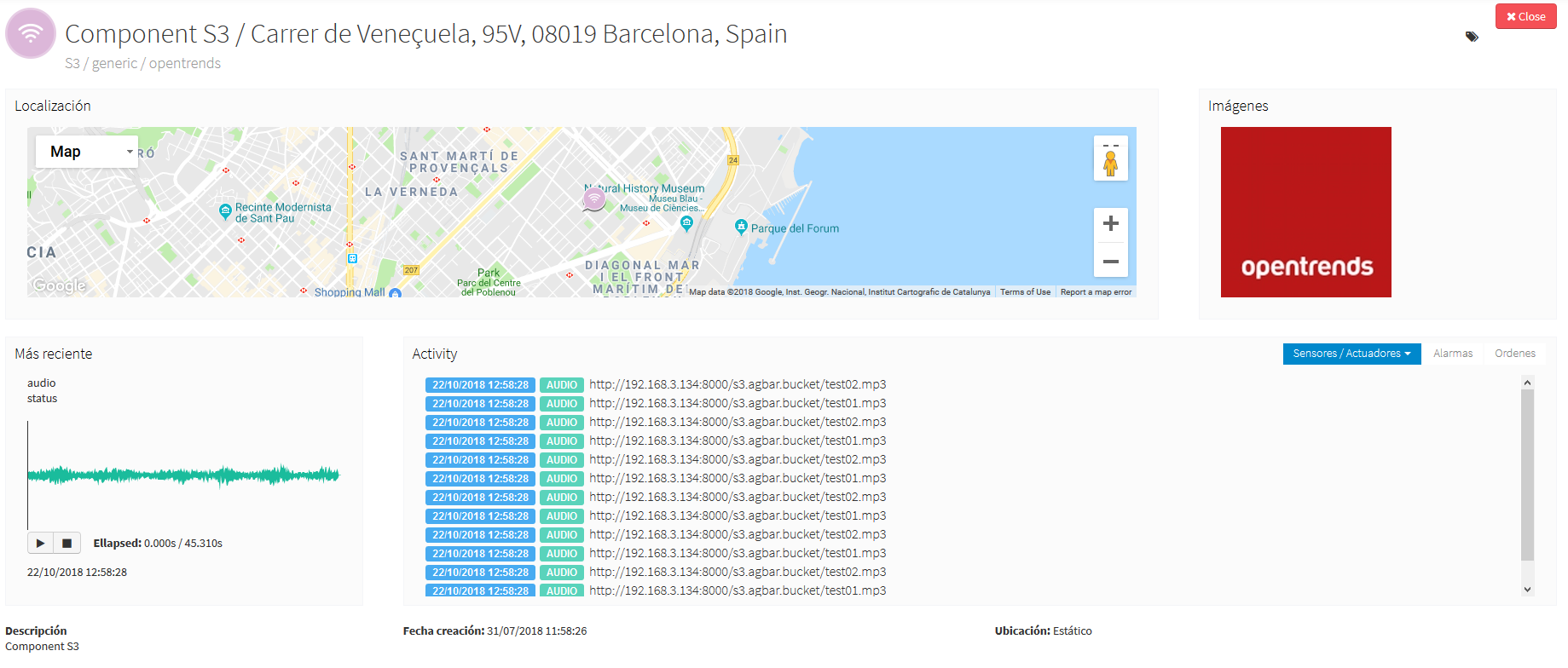Integrations¶
Agents¶
Agents are internal modules oriented to expand its functionality without having to alter its core. The installation is based on the principle of Plug & Play: they are recognized by the system and started automatically to be up and running.
Every agent is a process that acts as a subscriber for the publish/subscribe platform. These processes will subscribe directly to Redis as a independent clients. This subscription will provide the input data to do the underlying business logic (store in a relational database, process alarms, generate statistics, …)
The following diagram shows the design that every agent should follow:
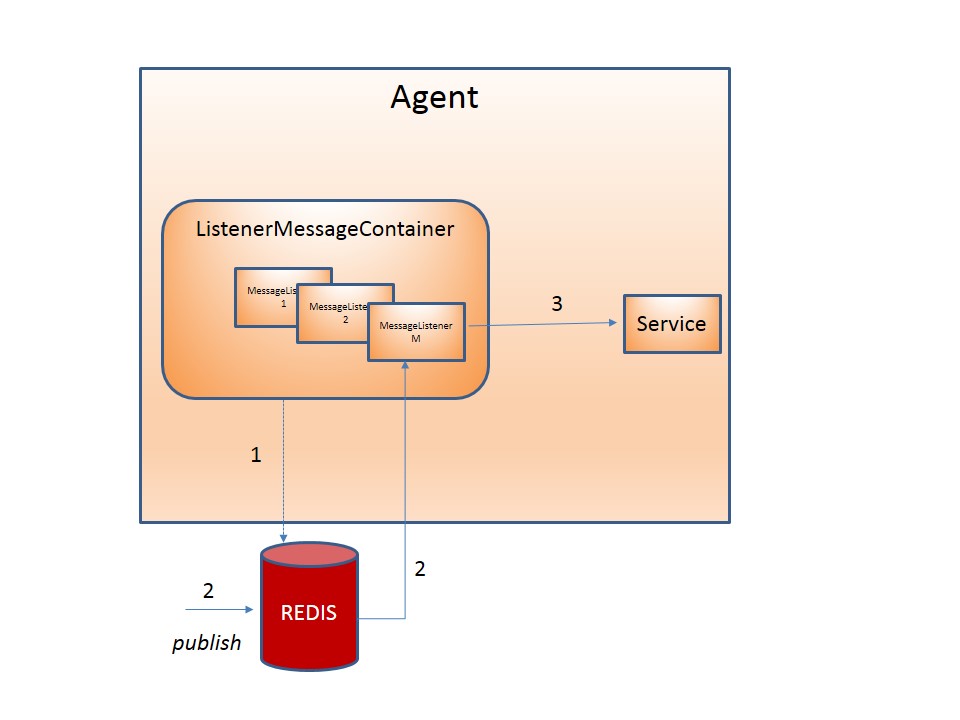
- When agent is started, it subscribes as client to Redis for the event that wants to receive notifications.
- When Redis receives a publication of any of these data, the agent is automatically notified with a new message.
- The message is processed and transferred to the corresponding agent’s service responsible to carry out the underlying business logic.
As mentioned above, Sentilo currently provides two agents:
Relational database agent¶
This agent stores all information received from PubSub platform into a set of relational databases (the number of relational databases is fully configurable). It could be configured to filter the data to store according to a business rules through a configuration file.
To do this, when the agent is started it makes a subscription to the desired information in Redis (observations, orders and/or alarms), that has previously been defined in a properties file:
//In this example we indicate to persist any data using a DataSource with srDs identifier,
//and also to store any data from provider with PARKING identifier,
//on a different DataSource whose identifier is parkingDs.
//Finally, we can indicate more than one DataSource destination to persist the same data.
data\:PARKING*=parkingDs
data\:*=srDs
order\:*=srDs
alarm\:*=srDs,parkingDs
It is imperative that the DataSources are defined in the context of the agent with the same identifier:
<bean id="srDs" class="org.apache.commons.dbcp.BasicDataSource"
destroy-method="close">
...
</bean>
<bean id="parkingDs" class="org.apache.commons.dbcp.BasicDataSource"
destroy-method="close">
...
</bean>
This context is defined in the file:
sentilo-agent-relational/src/main/resources/spring/relational-persistence-context.xml
Alarm agent¶
This agent processes each internal alert defined in the catalog and publish a notification (a.k.a. alarm) when any of the configured integrity rules are not met.
Due to the type of available rules, this validation process integrity is divided into two threads:
- An internal process that runs every minute, evaluates the status of each sensor that have associated (frozen type) alerts.
- Additionally, each time a Redis notification is received, alerts associated with the data received are evaluated.
Finally, an internal process regularly synchronize the alert list, to synchronize the information stored in memory with the catalog repository.
Activity Monitor agent¶
Background on Activity Monitor Agent
Sentilo is a publication-subscription platform. The amount of data held in the system is proportional to Redis deployment and directly depends on the amount of physical memory available for the Redis server. In another words, the data has to be probably deleted after a certain amount of time to free the Redis memory. For example, in the Barcelona deployment, the data is deleted after approximately one week.
Additionally to data expiration, Sentilo does not provide many dashboards and those dashboards are not customizable.
In order to fill the gap of historization and dashboards, we use Elasticsearch and Kibana. Elasticsearch is a powerful Java-based fulltext search database with REST API. It is frequently used together with it’s modules, Kibana for dashboards and Logstash for collecting of logs. The combination of Elasticsearch, Logstash and Kibana is often called the ELK stack. ELK provides a comfortable way to store and exploit historical information, and also a near-realtime monitoring of the platform. Note that Elasticsearch behaves excellently in cluster mode.
Sentilo events are uploaded to Elasticsearch through a Sentilo agent called Activity Monitor Agent. The configuration of this agent is described further in this chapter.
The following image illustrates a possible setup of Sentilo with ELK stack. Logstash is optional and can be used e.g. for monitoring of Sentilo logs (like login errors, invalid messages etc.), as well as monitoring of system resources.
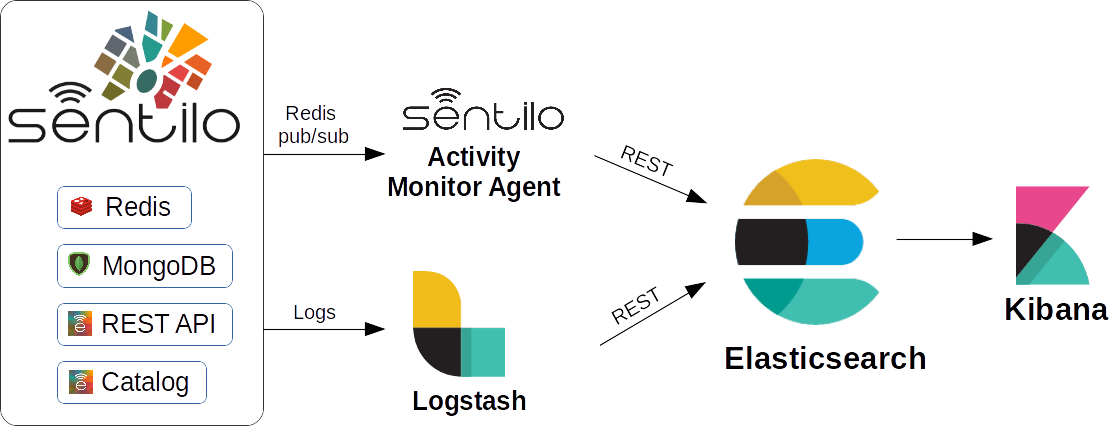
The setup of the ELK stack is well documented and beyond the scope of this page.
Configuration
Activity Monitor Agent is configured with a set of .properties files in
sentilo/sentilo-agent-activity-monitor/src/main/resources/properties.
subscription.properties
monitor-config.properties
| Property | Description | Comments |
|---|---|---|
| elasticsearch.url | URL of the ES instance | |
| batch.size | How many evens are sent to ES at once. | Every HTTP request consumes certain amount of resources, thus is convenient to use a ES bulk API. The agent won’t send events to ES until batch.size events occurred. |
| batch.workers.size | Number of threads the agent | Determines how many parallel threads communicate with ES. |
| batch.max.retries | Number of retries when ES is unavailable | Number of intents for upload to ES instance. |
The agent will create index(es) called sentilo-YYYY-MM.
Configuration of Elasticsearch, Logstash and Kibana is beyond the scope of this document and can be easily followed on their respective web pages.
Compatible versions
Sentilo has been successfully used in with these versions of ELK (which does not mean other versions shouldn’t work as well):
- ELK 5+
Historian agent¶
Background on Historian Agent
As you already might have learned, Sentilo does not persist data forever because of limited system resources.
Commonly used setup of a Sentilo instance is to employ one of the agents to copy the data into some external database or storage.
Since the data volumes can be fairly big and the data are mostly structured (except when the observations are text), it is convenient to use a scalable solution for time series such as OpenTSDB.
OpenTSDB installs of top of HBase and HDFS. Exposes a HTTP REST API and can be used from Grafana as one of it’s data sources.
Configuration
Historian Agent is configured with a set of .properties files in
sentilo/sentilo-agent-historian/src/main/resources/properties.
subscription.properties
monitor-config.properties
| Property | Description | Comments |
|---|---|---|
| opentsdb.url | URL of the OpenTSDB instance | |
| batch.size | How many evens are sent to OpenTSDB at once. | Every HTTP request consumes certain amount of resources, thus is convenient to use a OpenTSDB bulk API. The agent won’t send events to OpenTSDB until batch.size events occurred. |
| batch.workers.size | Number of threads the agent | Determines how many parallel threads communicate with OpenTSDB. |
| batch.max.retries | Number of retries when OpenTSDB is unavailable | Number of intents for upload to OpenTSDB instance. |
Configuration of HDFS, HBase, OpenTSDB and is beyond the scope of this document and can be easily followed on their respective web pages.
Compatible versions
Sentilo has been successfully used in with these versions:
- Hadoop 2.7.2
- HBase 1.2.1
- Opentsdb 2.2.0, 2.3.0
- Grafana 3 +
Federation agent¶
Description
The federation agent is a module that permits to share events between two independent instances of Sentilo. The sharing is unilateral - one Sentilo instance is emitting events and the other is receiving. The agent is installed at the side of the receiving instance:
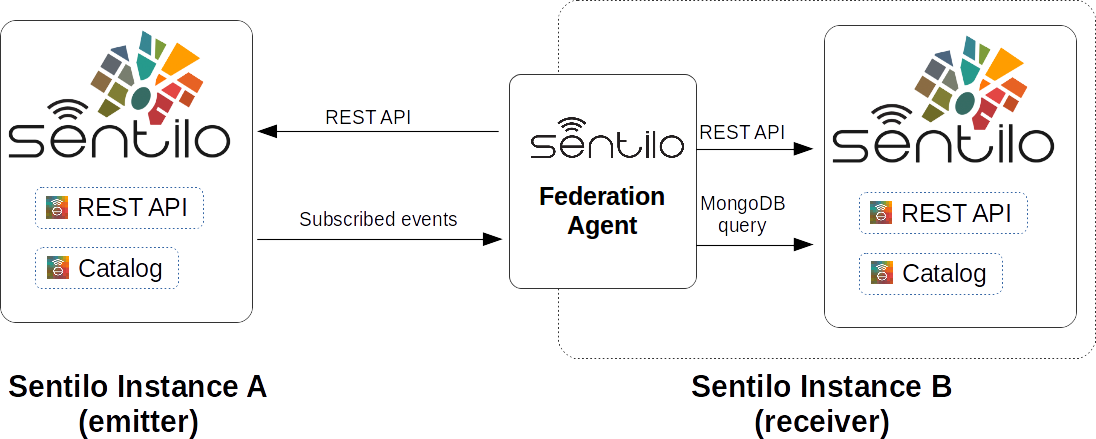
The administrator of the emitting Sentilo instance only needs to create a new application and provide the token the administrator of the receiving instance. As with any Sentilo application, the administrator is in control of which provider’s data are readable by the remote federation agent.
Providers, components and sensors are created automatically in the catalog of the receiving instance by the federation agent. The agent uses its application token to query the emitting catalog API to obtain remote objects, and uses the local catalog application id to replicate the locally.
The federation agent creates subscriptions on data it has permission. It creates a HTTP endpoint and tells the emitting instance to forward the events to this endpoint URL.
Configuration
Federation Agent’s configuration is in file
sentilo/sentilo-agent-federation/src/main/resources/properties/application.properties.
Further configuration of the agent is available in the “Federation services” menu.
The menu is available when running Tomcat with the option:
-Dsentilo.federation.enabled=true
The “Client application token” input is the token created in the emitting Sentilo instance:
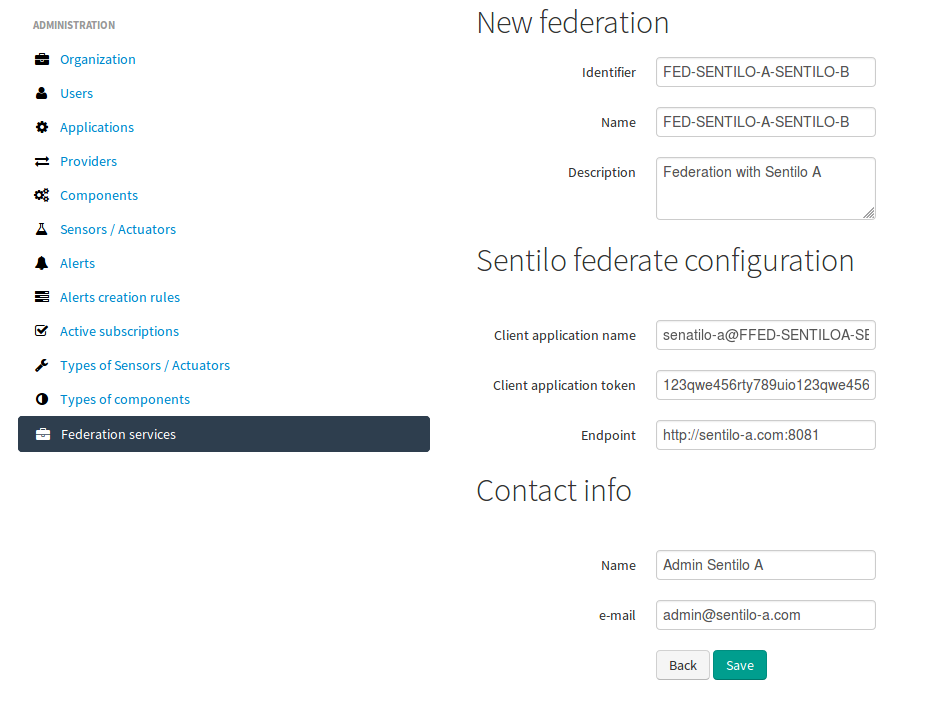
Kafka agent¶
Description
The Kafka agent publishes Sentilo events to Kafka.
Configuration
| Property | Default Value | Description |
|---|---|---|
| kafka.bootstrap.servers | localhost:9092 | Comma-separated list of Kafka brokers |
| zookeeper.nodes | localhost:2181 | Comma-separated list of Zookeeper nodes |
| batch.workers.size | 10 | Number of worker threads |
| batch.max.retries | 1 | How many times will the agent try to resend the message to Kafka until it gives up |
| kafka.request.timeout.ms | 30000 | |
| kafka.linger.ms | 100 | Milliseconds before the contents of buffer are sent or until batch fills up, whichever comes first. |
| kafka.batch.size | 20000 | Number of bytes of internal buffer. If the size fills up before , contents are sent to Kafka, . Otherwise contents are sent once kafka.linger.ms passed. |
| kafka.topicPrefix | sentilo | Topics in Kafka will start with following prefix. May be left blank |
| kafka.topicSeparator | . | The compound name of topic in Kafka will be separated with this string. |
| kafka.topicNameMode | topicPerSensor | Possible values of topicNameMode for the “data” event type: * topicPerSensor: sentilo.data.providerName.sensorName * topicPerProvider: sentilo.data.providerName * topicPerSensorType: sentilo.data.temperature * topicPerMessageType: sentilo.data * singleTopic: sentilo |
Compatible versions
Sentilo has been successfully used in with these versions:
- Kafka 0.11.0
- Kafka 0.10.2
Metrics Monitor Agent¶
The agent persists internal Sentilo metrics, such as memory usage or number of threads and persists them in Elasticsearch.
Elasticsearch template definition for this agent is located in
/sentilo-agent-metrics-monitor/src/main/resources/elasticsearch.
The template name is sentilo-metrics and the index pattern created by the agent is sentilo-metrics*.
The configuration /sentilo/sentilo-agent-metrics-monitor/src/main/resources/properties/monitor-config.properties
and it’s same as for the Activity Monitor Agent. Example configuration:
# Endpoint for elasticsearch elasticsearch.url=http://localhost:9200
# Properties to configure the index process batch.size=1 batch.workers.size=3 batch.max.retries=1
The difference with the Activity Monitor agent is the Redis topic in subscription.properties:
batch.max.retries=/metrics/*
Clients¶
Node-red¶
Node-RED is a visual programming platform ideal for non-complex integrations and prototyping.
Sentilo plugin is available in Node-RED’s marketplace. Simply search for “sentilo” in Palette configuration:
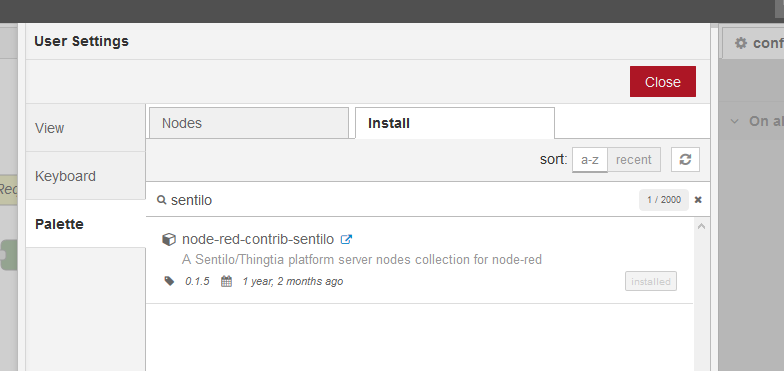
Following nodes should appear in the nodes palette:
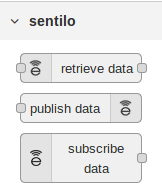
Now, you should be able to use Sentilo from Node-RED. For example:

The package contains documentation on how to use Sentilo nodes. More info at the `Sentilo library page at Node-RED website https://flows.nodered.org/node/node-red-contrib-sentilo`__.
NodeJS¶

We provide a Node.js client library that facilitate access to the Sentilo API. The library is no yet a npm package, but you can still use easily. Lastest version of this library is tested with Node 10 and 12.
More information is in this repository: https://github.com/sentilo/sentilo-client-nodejs
There is also a tutorial on how to use this library with Raspberry Pi and GPIO with javascript.
Java Client¶
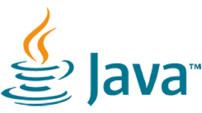
Sentilo platform includes a Maven artifact sentilo-platform-client-java.
Its source code is here.
This library is used internally by Sentilo and its agents.
You can check the tutorial of `how to create creating sample web application /tutorials/java_client_tutorial.html`__. The example uses Spring MVC and can be deployed on a Tomcat. The code of this tutorial is available at https://github.com/sentilo/sentilo-client-sample-java .
Regardless of the example, the library can be used in any Java application. Its dependencies are tiny and is framework-agnostic.
Arduino¶

Arduino client HTTP Request library is available here: https://github.com/sentilo/sentilo-client-arduino
There’s also a tutorial on Arduino with Sentilo. The source code for the tutorial is available here: https://github.com/sentilo/sentilo-client-arduino
Cloud¶
AWS S3¶
The AWS S3 can be used together with Sentilo, if your solution needs to upload files such as audio snippets, images or files in general.
Sensor can publish links to multimedia files. If these links are always public, catalog will preview them without any additional configuration.
If these media links are private and managed by S3, catalog needs these properties in the file catalog-config.properties:
Note
Sentilo is is currently using path-style API requests.
Note
Sentilo is probably compatible with variety of S3-like platforms on the market that implement the S3 interface.
In the end, you will be able to visualize private links in S3, for example:
